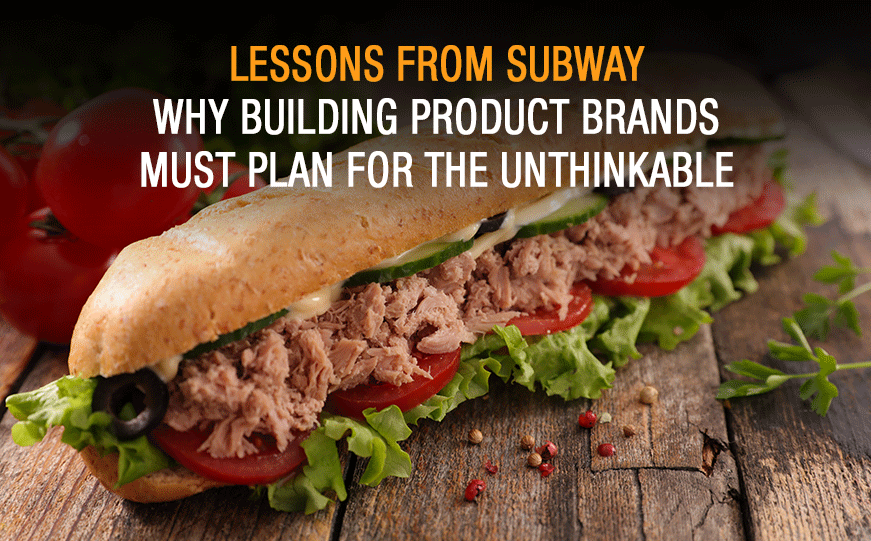Early this year, fast-food chain Subway was hit with a lawsuit alleging that their tuna sandwiches contained no tuna – and, well, no fish at all. While the company was ultimately exonerated, their response provides a lesson in how not to handle crises… that building products brands can learn from.
Subway’s response to the publicity that resulted from the lawsuit was to “get cute.” They had some fun on social media, poking fun at the frivolity of it all. And offered some discounts to try and get people back in the doors. They should have known better. Remember Jared?
Light-hearted social media posts have their place, and they certainly can be effective. But Subway failed to take the allegations seriously — at least in the eyes of audiences — and this caused them to lose trust.
It Can Happen to You
Building product brands might think they’re not subject to the kinds of crises that companies like Subway face. The quick service restaurant franchise is, after all, a major consumer brand — an iconic brand at that — whose ads most of us see every day. That makes them a huge target for lawsuits and allegations.
It’s easy to assume building product brands are somewhat insulated from the cut-throat world of consumer goods and fast food.
But that’s dangerous thinking. While a building product brand may be generally less likely to encounter a crisis — if, and when, one does happen — it could pose an existential threat.
A Real-World Example
That’s the situation that Innovative Stone, one of our clients, faced a few years ago. One of their competitors (as we later discovered) had planted stories in the media that granite countertops could cause cancer.
News like this would understandably concern homeowners and the surfaces channel. And it definitely threatened Innovative Stone’s sales through big box retailer, The Home Depot.
The situation required a quick response, and we stepped in to help Innovative Stone quickly address and overcome the challenge. We got in front of the problem, proactively.
Our approach included engaging scientific experts, and monitoring and engaging influencers in social media. And developing as well as distributing content — that clearly stated, and substantiated — Innovative Stone’s position: that naturally occurring radon from granite countertops was not a threat.
K&A’s PR strategy worked. And the brand’s sales remained steady, not missing a beat. You can learn the specifics of how we helped them by checking out our case study.
Lessons Learned
Of course, every situation is different… and no one can predict precisely what kinds of crises may arise. But Building Product Brands can plan for them. And be at the ready… that’s really the main lesson we can offer from our case study.
Here are some important strategies to consider in developing a plan of action.
Stay connected
It’s critical to have an established — and robust — presence on social media, along with strong relationships with print and digital media, and influencers.
If you wait until a crisis occurs to start posting on your LinkedIn or other social media platforms… it’ll be too late. Why? You simply won’t have a robust and influential audience built up. Much less enough goodwill or online reputation. So, the risk will exist, that your response will likely go unnoticed.
The same approach applies with traditional media. Maintaining relationships with key journalists in each region and industry channels means you’ll have a sympathetic ear… when the time comes to tell “your side of the story”.
Get with the plan
While it’s not particularly pleasant to think about “what could happen,” brands need to have a solid crisis communications plan in place.
Again — while you can’t know in advance what a unique crisis may entail — the foundation of your plan should include an understanding of who your audiences are. The best ways to reach them. And the roles that different spokespersons in your organization (and marketing agency) will have… when it comes to addressing the crisis.
Having a plan will allow you to focus on your response. Rather than wasting valuable time trying to decide who-needs-to-do-what. In crisis communications, a well-measured response is critical. And arguably, so is agility and the ability to act quickly.
Take it seriously
The most important lesson is to face the challenge head on… with a level of seriousness, greater than the threat itself. This is what made Subway’s blunder so catastrophic — they appeared glib and ill prepared. In the face of some issues that many people took very seriously.
The worst thing you can do is bury your head in the sand, hope the problem will go away and do nothing. That’s a surefire way to lose control of the narrative, and allow others to define who your brand is. And how it should act.
The good news is crises like the one Innovative Stone faced don’t happen very often. In fact, it may never happen to your brand. But, if it does, you’ll be glad you were prepared. And that preparedness could be the key to preserving — and even improving — your brand’s hard won reputation.
Interested in learning how to develop a proactive plan that will help your company emerge from a crisis better than before it started? Send an email to Steve Kleber at skleber@kleberandassociates.com.




